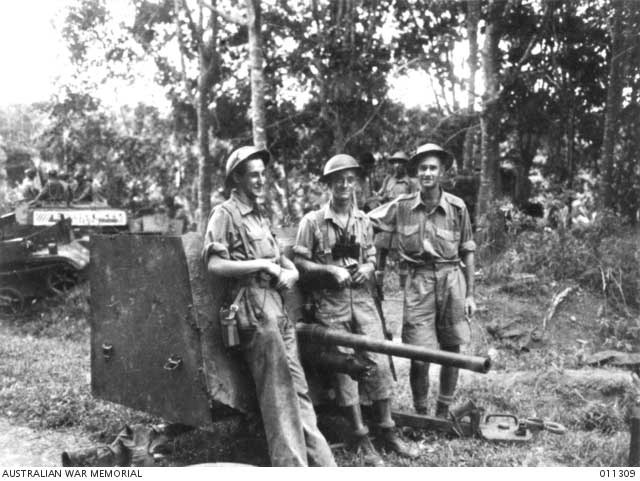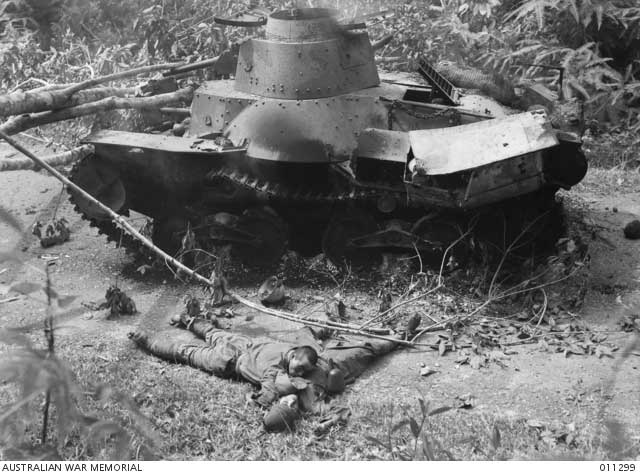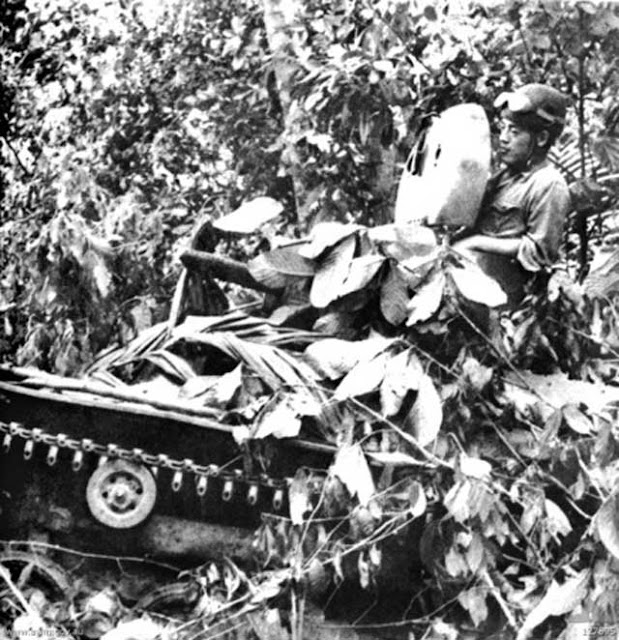Sunday 18 January 1942
 |
| "Malaya. Three Japanese Type 95 Ha-Go light tanks destroyed near Bakri by gunners from the 13th Battery, 4th Australian Anti-Tank Regiment." 18 January 1942. Australian War Memorial 011301. |
Eastern Front: On
18 January 1942, Soviet paratroopers begin the next phase of the Red Army counteroffensive at Moscow by dropping behind German lines south of Vyazma. The landings are conducted by the 201st Airborne Brigade and the 250th Airborne Regiment under the overall command of Lieutenant General Ivan Zatevakhin. Their objective is to cut the Vyazma-Yukhnov highway and the Vyazma-Bryansk railroad.
 |
| Soviet paratroopers during 1942. |
Following the pattern of German Fallschirmjaeger raids, these Red Army paratrooper landings make a big impact psychologically but do not lead to successes against key objectives. The Germans have few troops in the area - with all reserves having been committed at the front - and thus must redirect troops from the front to contain this unexpected threat. The major impact of the landings is to create a major distraction that helps the Red Army's 33rd Army and 1st Guards Cavalry Corps at the front further east.
 |
| "USS Arthur Middleton (AP-55). Departing New York on 18 January 1942 en route to the Pacific after interim conversion for Naval service at the Tietjen & Lang Dry Dock Co. yard in Hoboken, N. J. She operated as a civilian-manned convoy-loaded transport until arriving at San Francisco in June 1942 for final conversion to a combat-loaded (attack) transport." Photo No. 19-N-27271. Source: U.S. National Archives, RG-19-LCM. |
On the high road to Moscow, a long, grueling battle at Borodino Field finally ends in a Red Army victory. The battle, which began on 13 October 1941 and technically won that month by the Germans, now is won for good by the 82nd Soviet Rifle Division as it takes back the field. This battle is particularly memorable to Russians because of its echoes of the 1812 battle on the spot which technically was won by the French but was so costly that it became a Pyrrhic victory.
 |
| "A two-pounder Anti-Tank Gun of the 4th Anti-Tank Regiment, 8th Australian Division, AIF, directed by VX38874 Sergeant (Sgt) Charles James Parsons, of Moonee Ponds, Vic, in action at a roadblock at Bakri on the Muar-Parit Sulong Road. In the background is a destroyed Japanese Type 95 Ha-Go Medium Tank. The Anti-Tank Gun was known as the rear gun because of its position in the defense layout of the area. Sgt Parsons was later awarded the Distinguished Conduct Medal (DCM) for his and his crew's part in destroying six of the nine Japanese tanks during this engagement." This appears to be another view of the ambush which resulted in the demise of the three Japanese tanks shown in the top photo on this page. Australian War Memorial 011302. |
Army Group North also is facing mounting problems. A Red Army breakthrough south of Lake Ilmen works behind several German divisions ordered to hold Demjansk and surrounds them. Other Soviet troops are heading toward nearby Kholm to do the same thing. In Army Group South, however, the Germans are more successful and consolidate their hold on the key port of Feodosia, which they captured on the 17th. The focus of the battle there now shifts to the continuing assault on the Red Army line at the Parpach Narrows, which so far has been creaking but not giving way.
 |
| "The crew of the forward pom-pom pause for a cigarette while at their post." Aboard minesweeper HMS Beaumaris on 18 January 1942 (© IWM (A 7207)). |
Battle of the Atlantic: Operation Drumbeat, the German U-boat offensive along the east coast of the United States, shifts into high gear. There are now several U-boats in position, and easy targets are everywhere. There are mounting successes on the far side of the Atlantic, with several today very close to Newfoundland:
- U-66 (KrvKpt. Richard Zapp) torpedoes and sinks 6635-ton US tanker Alan Jackson east of Cape Hatteras;
- U-86 (Kptlt. Walter Schug) torpedoes 4271-ton Greek freighter Dimitrios G. Thermiotis off Newfoundland (U-86 is not actually part of Operation Drumbeat and simply sinks a member of Convoy SC-63);
- U-333 (Kptlt. Peter-Erich Cremer) torpedoes and sinks 5851-ton US freighter Caledonian Monarch of Convoy SC-63 off Newfoundland (also not a part of Operation Drumbeat, and some sources place this sinking on 22 January);
- U-552 (KrvKpt. Erich Topp) torpedoes and sinks 2609-ton US freighter Frances Salman off Newfoundland (U-552 is operating as part of Wolfpack Ziethen);
- U-123 (Kptlt. Reinhard Hardegen), having headed south from New York City, shells and then torpedoes 8206-ton US freighter Malay. The tanker makes it to Hampton Roads. Some sources place this incident on 19 January.
Operation Drumbeat is turning into a dramatic overall success for the Kriegsmarine and is embarrassing the US Coast Guard. After a long quiescent period, the Battle of the Atlantic is picking up again.
 |
| "Gunner and look-out on the alert for any intruders." Aboard minesweeper HMS Beaumaris on 18 January 1942 (© IWM (A 7203)). |
Battle of the Pacific: The Allied forces continue to try to restore their lines after recent Japanese incursions. On the eastern II Corps front, the US 31st Infantry Division continues attacking along the western portion of the front but makes little headway along the Balantay River. The Filipino 45th Infantry Division of the Philippine Scouts makes some ground to the west of the Balantay River and reaches the most advanced 31st Division troops. The fighting is savage and deadly in the thick forests. Further west, in the I Corps area, the Japanese along the coast in Morong Province send some troops east behind the Allies in order to isolate them and dislodge the entire Allied line. About 5000 Japanese troops under General Kimura capture Poblacion, Morong Province, and burn it almost entirely to the ground, leaving only a few buildings for their own use.
 |
| The Brooklyn Eagle of 18 January 1942 trumpets fake victories in Tokyo Bay while real victories are proving scarce. However, unknown to the media, a US submarine is, in fact, operating very close to Japan and is beginning to score successes. |
US submarine USS Plunger (Capt. David C. White), on its first war patrol, claims a rare (so far) victory in Japanese territorial waters. Operating south of Kobe at the mouth Kii Suido, Honshu, it torpedoes and sinks Japanese merchant cargo ship Eizon Maru. The success confirms the effectiveness of the new Mark VI magnetic exploder for the Mark 14 torpedoes. The Plunger also successfully uses a new sonar (SD radar) set which confirms that the Japanese themselves are using echo-ranging sonar ("pinging"). White and his crew survive a brutal depth charge attack before sinking the freighter.
 |
| "A two-pounder Anti-Tank Gun of the 4th Anti-Tank Regiment, 8th Australian Division, AIF, directed by VX38874 Sergeant (Sgt) Charles James Parsons, of Moonee Ponds, Vic (center), with two crew members, identified as Gunner (Gnr) Len Coutts and Gnr Ken Daniels, standing against their Anti-Tank Gun in a clearing near the roadblock at Bakri on the Muar-Parit Sulong Road. The Anti-Tank Gun was known as the rear gun because of its position in the defense layout of the area. Sgt Parsons was later awarded the Distinguished Conduct Medal (DCM) for his and his crew's part in destroying six of the nine Japanese tanks during this engagement." 18 January 1942. Australian War Memorial 011309. |
On the Malay Peninsula, the battered Indian 45th Brigade continues a difficult defensive battle in the Muar/Yong Peng area. The troops destroy some Japanese tanks, but the Japanese bring reinforcements up by sea north of Batu Pahat. At the end of the day, the 45th Brigade comes under the command of Indian 3 Corps and ordered to withdraw. After dark, the Indian 9th Division and Australian 27th Brigade Group, in danger of being cut off, withdraw behind the Muar and Segamat Rivers, respectively. The 6/15th Infantry Brigade stands on the south bank of the Batu Pahat River - it is augmented during the day by D Company of the 2nd Battalion of the Malay Regiment, which retreats back across the river. The Japanese are right behind D Company and immediately begin infiltration operations.
At Muar, General Takuma Nishimura orders his 4th and 5th Guards Regiments to attack Bakri. The attack is led by nine Type 95 Ha-Gō light tanks under Captain Shiegeo Gotanda. The attack goes disastrously wrong, however, when the tanks unwisely advance without infantry support and are destroyed by Australian gunners of the 2/29th Battalion. However, the battle is not an unalloyed victory for the Australians, as the Japanese kill the commander of the battalion, Lieutenant Colonel John Robertson, while he is leading his troops during an attack along the main road. The battle is bloody, but the Australians succeed in halting the Japanese, who are forced to regroup now that they have no tanks left.
 |
| "Malayan Campaign, December 1941-January 1942. American Fighter Planes Over Malaya. American fighter planes have arrived in Malaya after month and assembly has continued at high speed but without publicity. Singaporeans have become used to the long, grey crates passing through the streets and hardly notice the roar of engine and whistle of wind past fuselage as the fighters are rested near and over the city. But the planes are here in great numbers – distributed strategically throughout Malaya. Shown are Brewster Buffalo fighters over the Malaya coasts. This photograph released circa 1942. Office War Information Photograph. Courtesy of the Library of Congress. (2016/01/22)." National Museum of the US Navy. |
Back in Singapore, the daily Japanese bombing forces the RAAF to withdraw across the Malacca Strait to Sumatra. This drastically curtails Allied air defenses both over the fortress and the decisive battles underway just to the north.
Axis Relations: The main signatories of the Tripartite Pact - Italy, Japan, and Germany - sign a new military pact in Berlin. However, it is of little value given that there is little more they can do to help each other than they are doing already. In other words, the big decisions have all been made, and now it is just a question of fighting it out to victory or defeat.
 |
| A US Navy cable memo ordering destroyers to visit Londonderry. As the memo states, "These will be the first U.S. Warships officially to visit a British port in this war, except for the U.S. trawler Albatross which arrived at Londonderry a.m. today, 18th January, having been driven there by the stress of weather." Note that the typewriter paper of the day was very thin and showed pages below. |
US Military: In order to protect Dutch Harbor, units of the US Army Corps of Engineer land at Umnak Island in the Aleutians to build an airfield. This becomes Otter Point Airfield (Cape Field), part of Fort Glenn.
British/Burmese Relations: Just like in other Asian colonies, there are pressures for independence in Burma. One of the most influential proponents of this policy is U Saw, Burma's prime minister. Saw has been in England negotiating openly with the British for promises of independence after the war and also secretly with the Japanese for promises of independence during the war. The British, through the Ultra service, learn about the latter and imprison U Saw during a stop at Haifa, Palestine.
 |
| "A big thrill, a young ATC boy has a parachute fitted and is shown how to use the safety cord in case." 18 January 1942 at the Royal Naval Air Station at Donibristle. © IWM (A 7201). |
German Homefront: Publicized by the Ministry of Propaganda as a gesture of solidarity with the troops at the front, restaurant patrons now are served only "field-kitchen meals" every Monday and Thursday. Such meals typically consist of thin vegetable soup and a slice of bread. Customers are allowed, however, to bring their own ingredients with them and have the "field kitchens" prepare their meals any way they like. German civilians otherwise remain largely unaffected by the privations being suffered in England, Occupied Europe, and large swathes of the Soviet Union, as military conquest has brought vast new resources under German control. Hitler feels that it is important to the war effort to shield German civilians from the consequences of the war for as long as possible except in such "noble" ways.
American Homefront: New York Yankee Joe DiMaggio is named American League Player of the Year (his second of three such awards). This follows his unmatched 56-game hitting streak. Finishing second is Boston Red Sox slugger Ted Williams, who hit over .400. Neither feat has been equaled since. Both men wind up in the military during World War II.
 |
| Oliver Hardy, left, cuts the cake at this 50th birthday party on 18 January 1942 backstage at a Chicago theater while Stan Laurel looks on. As part of the act, Laurel wears a tag that says "Freight." |
1942January 1942January 1, 1942: Declaration By United NationsJanuary 2, 1941: Manila Falls to JapanJanuary 3, 1942: ABDA Command AnnouncedJanuary 4, 1942: MacArthur on His Own in the PhilippinesJanuary 5, 1942: Soviets Plan General OffensiveJanuary 6, 1942: US Army in EuropeJanuary 7, 1942: Soviet General Offensive OpensJanuary 8, 1942: Hitler Sacks HoepnerJanuary 9, 1942: Battle of DražgošeJanuary 10, 1942: Building the JeepJanuary 11, 1942: Japan Takes Kuala LumpurJanuary 12, 1941: Rommel Plans CounterattackJanuary 13, 1942: First Ejection Seat UseJanuary 14, 1942: Operation Drumbeat First SinkingJanuary 15, 1942: U-Boat Off NYCJanuary 16, 1942: Carole Lombard CrashJanuary 17, 1942: British Take Halfaya PassJanuary 18, 1942: Soviet Paratroopers in ActionJanuary 19, 1942: FDR Approves Atomic BombJanuary 20, 1942: The Wannsee ConferenceJanuary 21, 1942: Parit Sulong Bridge BattleJanuary 22, 1942: Parit Sulong MassacreJanuary 23, 1942: Japan Takes RabaulJanuary 24, 1942: Battle of Makassar StraitJanuary 25, 1942: Kholm SurroundedJanuary 26, 1942: GIs Land in EuropeJanuary 27, 1942: Battle of EndauJanuary 28, 1942: Rommel Takes BenghaziJanuary 29, 1942: First US Coast Guard Ship SunkJanuary 30, 1942: Singapore IsolatedJanuary 31, 1942: Army Group South Averts Disaster2020
































